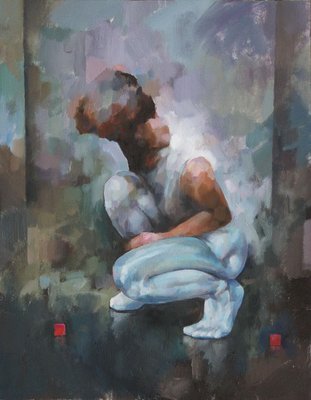Figurative Oil Painting: From Principle to Canvas - A Step-by-Step Technique
Figurative Oil Painting: From Principle to Canvas - A Step-by-Step Technique
Blog Article
The Function of Emotion and Expression in Metaphorical Oil Painting: A Comprehensive Evaluation of Topic Matter and Composition
The interplay of emotion and expression in metaphorical oil paint acts as an essential lens whereby one can check out the elaborate partnership between subject and structure. Artists harness numerous strategies, from shade option to brushstroke dynamics, to grow emotional vibration within their works. This nuanced orchestration not just shapes audience perception yet likewise invites a much deeper questions into how these components integrate to mirror the intricacies of human experience. As we discover this abundant terrain, one must take into consideration exactly how specific study light up the broader ramifications of these creative options.
Recognizing Emotion in Art
Feeling in art works as a powerful channel for expression, permitting artists to convey intricate feelings through their job. In figurative oil paint, this emotional depth is usually depicted via the depiction of the human number, recording the nuances of human experience. The option of subject matter, color combination, and brushwork all add to the psychological resonance of an item.
Artists regularly draw upon personal experiences, societal concerns, or universal styles to stimulate sensations in the viewer. As an example, a picture might mirror vulnerability, while a vibrant figure in movement can represent liberty or chaos. These psychological threads attach the customer to the art work, cultivating a dialogue that goes beyond the aesthetic medium.
Additionally, the interaction in between light and shadow can intensify psychological intensity, directing the audience's gaze and accentuating particular elements within the composition. The use of texture in oil paint better includes layers of intricacy, welcoming a responsive action that enhances the psychological experience. On the whole, understanding feeling in art is critical for valuing the nuances that identify figurative oil paint, as it changes simple representation right into a profound exploration of the human condition.
Trick Components of Structure
In the world of metaphorical oil paint, the composition functions as the underlying structure that arranges aesthetic aspects and enhances the psychological story. Crucial parts of structure include equilibrium, comparison, prime focus, and rhythm, each adding to the overall influence of the artwork.
Equilibrium refers to the distribution of aesthetic weight within the painting, which can be achieved via unbalanced or balanced arrangements. A well-balanced make-up supplies stability, allowing the visitor to engage with the item sympathetically - figurative oil painting. Contrast, on the other hand, involves juxtaposing various elements, such as light and dark or warm and cool shades, to direct the viewer's eye and stimulate psychological actions
The focal point is critical, as it guides attention to one of the most considerable component of the painting, commonly highlighting the psychological core of the narrative. Via methods like shade saturation or placement, musicians can emphasize this area properly. Lastly, rhythm refer to the repetition of aspects, developing a sense of motion and flow throughout the structure. By masterfully integrating these crucial elements, artists can craft mentally powerful and compelling metaphorical oil paints that astound and engage their audience.
Topic and Its Influence
Topic plays a critical function in figurative oil painting, as it not just offers as the structure for the story however additionally forms the viewer's interpretation and psychological engagement with the art work. The selection of subject-- be it a singular number, a team dynamic, or a thematic representation-- straight affects the psychological atmosphere shared to the target market.

As an example, portraits frequently evoke individual connections, disclosing the ins and outs of human expression and personality, while scenes showing common tasks can produce a feeling of belonging or fond memories. The historical and social context of the subject matter enriches the visitor's understanding, triggering much deeper reflections on social standards, worths, and the human condition.
Various topics also produce differing levels of interaction; a significant conflict illustrated through figures in stress may evoke feelings of stress and anxiety or compassion, while calm landscapes can invoke harmony and contemplation. Eventually, the influence of topic in metaphorical oil paint is extensive, as it serves as a channel for emotional resonance, assisting the viewer's reaction and analysis, and fostering a connection between the observer and the artwork. This interaction is essential for the successful communication of the artist's intent.
Strategies for Stimulating Sensations
The effectiveness of figurative oil painting in communicating feelings is dramatically affected by the strategies used by the musician. One of one of the most essential techniques is the usage of shade concept, where the calculated selection of colors can stimulate certain psychological feedbacks. Cozy shades, such as reds and oranges, often evoke feelings of enthusiasm or hostility, while cooler tones like blues and eco-friendlies have a tendency to evoke peace or unhappiness.
One more vital method is the adjustment of light and darkness, referred to as chiaroscuro. This approach improves the three-dimensionality of figures, producing significant contrasts that can increase psychological depth. The placement of light can direct audiences' emotions, highlighting particular elements of the make-up.
Brushwork additionally plays a crucial duty; loose, meaningful strokes can communicate energy and spontaneity, whereas smoother methods might recommend harmony or precision. The arrangement of topics within the structure can influence psychological effect. Close proximity can recommend affection, while distance may suggest seclusion.
Inevitably, the combination of these strategies enables musicians to craft stories that resonate with the customer, changing a plain visual experience into an evocative emotional trip. - figurative oil painting

Instance Researches of Noteworthy Functions
Taking a my company look at notable jobs of metaphorical oil paint discloses just how various techniques are employed to stimulate powerful feelings. One excellent instance is Edvard Munch's "The Scream," where the distorted number and swirling background communicate existential dread. Munch's use color-- vibrant oranges and deep blues-- heightens the emotional impact, showcasing exactly how palette options can shape visitor experience.
An additional considerable job is Pablo Picasso's "Les Demoiselles d'Avignon." Right here, fragmented kinds and vibrant brushstrokes mirror a troubled emotional landscape, challenging typical representations of the female number. Picasso's ingenious structure not just records the viewer's attention yet additionally invites contemplation on themes of identification and sexuality.
In Addition, Frida Kahlo's "The Two Fridas" provides an emotional exploration of duality and self-identity. The different figures, linked by a common heart, exemplify Kahlo's emotional deepness and personal narrative. figurative oil painting. Her meticulous focus to detail and symbolic elements offer to engage customers on a visceral degree
These study emphasize the extensive connection in between emotion and make-up in figurative oil paint, exposing how musicians harness strategy to interact complicated sensations and stories that resonate across time and culture.

Final Thought
In final thought, the interplay of emotion and expression in figurative oil painting considerably enhances the visitor's experience and analysis of the artwork. Via a cautious option of subject issue and compositional methods, artists communicate extensive narratives that reverberate on both global and individual levels. The application of color brushwork, concept, and chiaroscuro further intensifies emotional depth, transforming each canvas into a powerful representation of the intricacies of the human experience.
In metaphorical oil paint, this emotional deepness is typically represented via the depiction of the human number, catching the nuances of human experience.In addition, the interplay between light and shadow can amplify emotional strength, directing the viewer's gaze and attracting focus to particular elements within the make-up. The usage of texture in oil painting even more includes layers of complexity, welcoming a responsive reaction that enhances the emotional experience.The focal factor is crucial, as it routes attention to the most substantial component of the paint, typically highlighting the emotional core of the story. Eventually, the influence of subject issue in metaphorical oil painting is profound, as it offers as an avenue for emotional visit their website vibration, leading the click here to find out more viewer's response and analysis, and promoting a link between the onlooker and the artwork.
Report this page